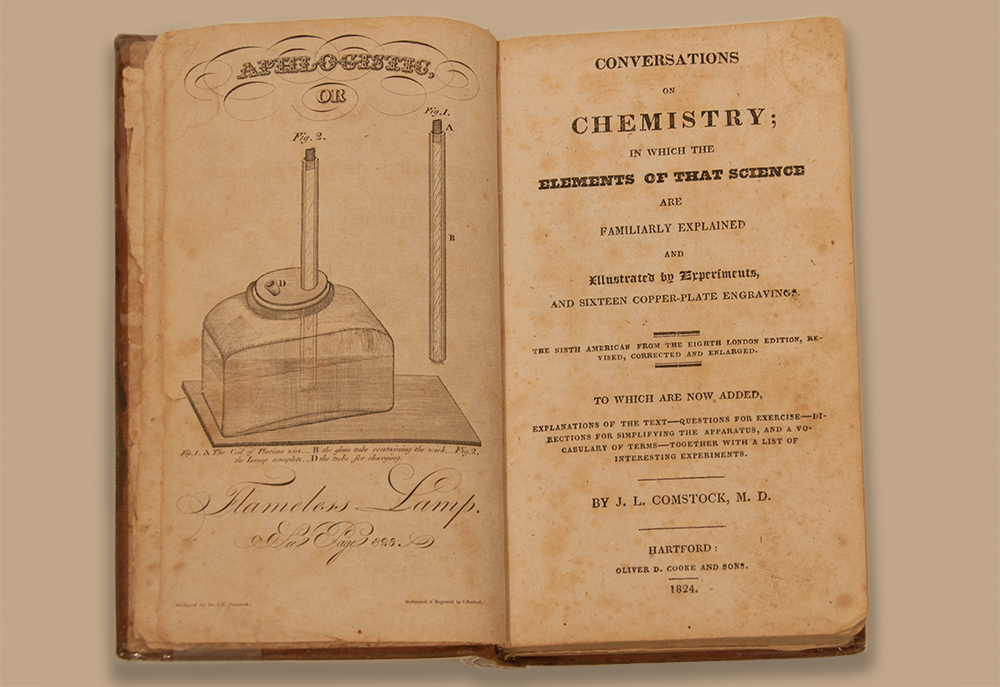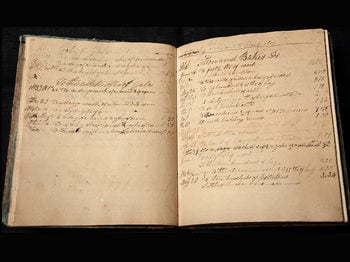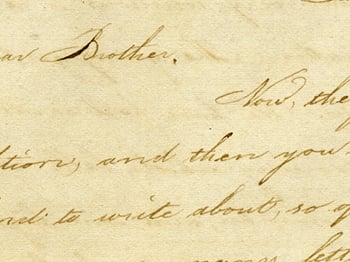
Among the many treasures in the historical collection at Longyear Museum is a group of books that belonged to the Baker family – the family in which young Mary Baker grew up and received her early education. Writing years later, Mary Baker Eddy mentions specifically some of these books she studied as a child.
A closer look at the schoolbooks in her home reveals her exposure at an early age to the concepts and reasoning expressed in the philosophy, rhetoric, and science of the day. We get insights into her growing understanding, and sometimes even glimpses of themes or turns of phrase that would be echoed in her later writings.
An example of this is a copy of Conversations on Chemistry,1 more popularly known as Comstock’s Chemistry. How telling that it was a notable enough textbook for Mrs. Eddy to remember and mention so many years later in an article she wrote for the Boston Journal in 1903, in which she explains her educational background:
I was early a pupil of Miss Sarah J. Bodwell, the principal of Sanbornton Academy, New Hampshire, and finished my course of studies under Professor Dyer H. Sanborn, author of Sanborn’s Grammar. Among my early studies were Comstock’s Natural Philosophy, Chemistry, Blair’s Rhetoric, Whateley’s Logic, Watt’s “On the Mind and Moral Science.”2
Comstock’s Chemistry was not actually written by Comstock (whose name appears on the title page), but by an English woman by the name of Jane Marcet, who lived in London for many years. She was rarely given credit for her work, although her book went through numerous editions in both England and the United States, where it was the most popular chemistry text during the first half of the 1800s. She presented chemistry as a series of conversations among a hypothetical teacher – Mrs. B. – and two students – Emily and Caroline. The following is an example of one these conversations – this one about how the sense of touch may be deceptive:
Mrs. B.: The fire which burns in the grate, communicates its heat from one object to another, till every part of the room has an equal proportion of it.
Emily: And yet this book is not so cold as the table on which it lies, though both are at an equal distance from the fire, and actually in contact with each other, so that, according to your theory, they should be exactly of the same temperature.
Caroline: And the hearth, which is much nearer the fire than the carpet, is certainly the colder of the two.
Mrs. B.: If you ascertain the temperature of these several bodies by a thermometer (which is a much more accurate test than your feeling), you will find that it is exactly the same.
Caroline: But if they are of the same temperature, why should the one feel colder than the other?
Mrs. B.: The hearth and the table feel colder than the carpet or the book, because the latter are not such good conductors of heat as the former. [Heat] finds a more easy passage through marble and wood, than through leather and [wool]; the two former will therefore absorb heat more rapidly from your hand, and consequently give it a stronger sensation of cold than the two latter, although they are all of them really of the same temperature.
Many years after studying this schoolbook, Mrs. Eddy made her discovery of Christian Science. Might this dialogue in Comstock’s Chemistry have given her a hint at a young age of the illusory nature of the material senses? Yet her discovery would move her far beyond Comstock’s and enable her to write many years later in the Christian Science textbook, Science and Health with Key to the Scriptures, “Heat and cold are products of mortal mind.”3
Several of the Baker children’s schoolbooks are on display in the Museum’s main exhibit, Mary Baker Eddy: A Spiritual Journey. Like Comstock’s Chemistry, they provide some evidence of what comprised the early education of the Discoverer, Founder, and Leader of Christian Science.4









